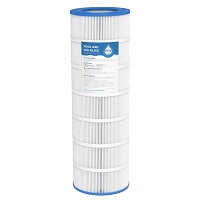When you have a pool, you want to ensure you have access to it all summer long. Unfortunately, bacteria and contaminants can get in the way of enjoying a big splash, especially when you aren’t utilizing the proper pool filter. While it’s true that chlorine and other sanitizers work hard to kill various contaminants, other elements are known to contribute to the growth and colonization of bacteria. If you are struggling to see the point in filtration, try associating a pool filter with your liver. Although your body may employ other means to keep your body free from dangerous bacteria, it’s the liver that is the true work horse of the human body.
Without a pool filter, debris virtually remains untouched, which quickly leads to cloudy pool water. On the other hand, when a filter is not properly maintained on a schedule, it can lead to dangerous swimming conditions. Either situation further highlights the importance of owning a decent pool filter, as well as keeping up on scheduled maintenance. But how do you know you’re choosing the best filter for your pool? Let’s dive further into pool filter options, and determine which filter offers the features you’re looking for.
Types of Pool Filters
Choosing the best pool filter comes down to knowing exactly what your options are, so let’s get right to it. There are three types of pool filters available, including: cartridge, diatomaceous earth (or D.E.), and sand. Each type of filter comes with differing replacement frequency, filtration rate, price, and cleaning method. In addition to overall microns, you need to understand the function and basic mechanics of each pool filter before you make your final selection.
Cartridge Filters
Cartridge filters provide easy maintenance, with sufficient effectiveness as long as it isn’t used with a large pool. They tend to run on the expensive side, and feature a tank smaller than that of a sand filter. The internal plastic cylinder is surrounded by polyester filter media, with caps on each end. It works by pulling water through the polyester pleats, capturing debris as small as 10 microns, before it flows through to the pool water.
Overall this type of pool filtration is inexpensive and efficient, collecting a variety of contaminants. As such, there is a bit more physical work involved, considering cartridge filters require cleaning rather than backwashing. This is done by removing the cartridge, and spraying it what a garden hose in order to remove dirt and debris. You may also opt to utilize filter cleaner from time to time, soaking the cartridge filter in chemical filtration, etc.
Pros of Cartridge Filters
- Doesn’t Require Backwashing
- Creates Less Water Waste
- Removes Contaminants as Small As 10 Microns
- Performs Well at Low Speeds
- Works with Variable Speed Pumps
Cons of Cartridge Filters
- Requires a Deep Clean Every 6 Months
- Has a Lifespan of 2 to 3 Years
- Involves More Work Compared to Other Filters
Diatomaceous Earth Filters
This type of pool filter involves more maintenance than any other type, because it is capable of removing the smallest contaminants – as small as 5 microns. Essentially, the tank in a D.E. Pool filter utilizes grids, or fingers, covered in white powder (diatomaceous earth). D.E. Is comprised of tiny fossils made up of silica, which is commonly used in cosmetics, toothpaste, and pest control. When it’s used in pool media, the D.E. Is heat treated to keep it in place for proper operation. As a side note, it’s unwise to sprinkle diatomaceous earth, so please do not experiment here.
Pros of D.E. Filtration
- Captures Tiny Particles <5 Micron
- Works Well With Bigger Pools
- Doesn’t React With Pool Chemicals
Cons of D.E. Filtration
- Costs More to Operate
- Requires More Maintenance
Sand Pool Filter
Homeowners on a budget will appreciate the sand filter above all others, especially with the minimal maintenance requirements. Large pools benefit most from sand filtration, because it doesn’t clog easily. As the pool pump operates, water is sucked in through a skimmer, and pushed through a large sand filled filtration tank. The media utilized inside a pool filter is #20 silica sand, which is capable of grabbing particles measuring 20 microns or larger. Grains of sand contained therein are of a prickly nature, when viewed under a microscope. Essentially, each grain possesses rough edges on every side, which is how it is able to grab contaminants as they pass by.
Over time, with regular use, the filter’s overall efficiency and capabilities decrease as the grain’s rough edges wear down by erosion. This type of filter also benefits from a pressure gauge, in order to provide a reading in regard to internal pressure. As internal pressure increases, the gauge will provide a warning as to when a backwash should be completed. Whenever a backwash is done the filter flow is reversed, which enables debris and waste to wash out of the filter and away from pool water. Considering that silica captures particles of 20 microns or more, it’s crucial to stay on top of pool chemistry in order to sanitize tiny bacteria.
Pros of Sand Pool Filters:
- Lower Overall Costs
- Simple Maintenance
- Replace Sand Every 5-7 Years
- Efficiency Benefits from Various Additional Media
Cons of Sand Pool Filters
- Backwashing and Rinsing Waste Water
- Filter Efficiency Decreases with Increased Pressure
- Least Effective with 20 Micron Filter
Troubleshooting Pool Filters
Overall maintenance is crucial to the proper operation of pool filters, so you can enjoy your pool all season long. In order to prevent your filter from running into common problems, regular maintenance is key. However, should you find your filter to show signs of a common issue, there may be a simple solution.
Leaks
When a homeowner observes water dripping from around the filter, or a small puddle underneath, it’s more than likely to have sprung a leak. Leaky filtration won’t create significant water loss, but it can become a larger problem without proper attention. You should work to identify the source of leak, checking for holes and patching as necessary. In the event of more serious damage it may be necessary to replace the entire tank. Additionally, a worn or torn O-ring is a common cause of leaks, but easy to replace with another set of hands. This can be prevented by keeping the ring hydrated during use.
Cycling Issues
A flow rate problem may arise from filters running in short cycles – even if the pool is not in use. If your pool pump is too strong for your filter, a flow rate that is too high creates flow rate problems. Basically, this occurs when your pool filter is inadequate for overall pool size. If this happens with appropriate filtration and pump pairing, you need to attempt a backwash. You should continue a backwash until the water is crystal clear, which involves several minutes of waiting. This could also be a problem of clogs or algae wearing down your filter, and it’s in need of a deep clean or total replacement.
The Best Filter for You
By spending a little time researching the aforementioned styles of pool filtration, you are one step closer to finding the perfect filter for you. When all the right parts are in place, there is nothing more enjoyable than time at the pool with your family. The right pool filter means you will get the most out of your investment, and enjoy your pool for years to come.

